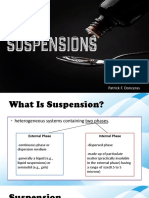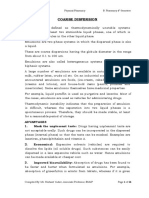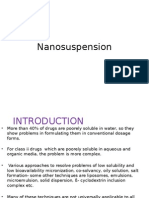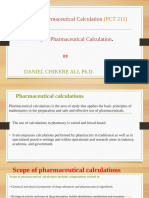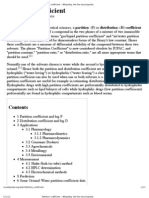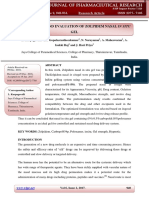Particle Size Analysis
Uploaded by
VladimirodipostovParticle Size Analysis
Uploaded by
VladimirodipostovParticle Size Analysis
AM Healy
Particle Size Analysis
Why measure particle size of pharmaceuticals??? Particle size can affect Final formulation: performance, appearance, stability Processability of powder (API or excipient)
April 2010
Particle Size Analysis
AM Healy
Methods for determining particle size
Microscopy Sieving Sedimentation techniques Optical and electrical sensing zone method Laser light scattering techniques (Surface area measurement techniques)
April 2010
Particle Size Analysis
AM Healy
Choosing a method for particle sizing
Nature of the material to be sized, e.g. estimated particle size and particle size range solubility ease of handling toxicity flowability intended use Cost capital running Specification requirements Time restrictions
April 2010
Particle Size Analysis
AM Healy
Microscopy
Optical microscopy (1-150m) Electron microscopy (0.001-)
Being able to examine each particle individually has led to microscopy being considered as an absolute measurement of particle size. Can distinguish aggregates from single particles When coupled to image analysis computers each field can be examined, and a distribution obtained. Number distribution Most severe limitation of optical microscopy is the depth of focus being about 10m at x100 and only 0.5m at x1000. With small particles, diffraction effects increase causing blurring at the edges - determination of particles < 3m is less and less certain.
April 2010
Particle Size Analysis
AM Healy
For submicron particles it is necessary to use either TEM (Transmission Electron Microscopy) or SEM (Scanning Electron Microscopy). TEM and SEM (0.001-5m)
April 2010
Particle Size Analysis
AM Healy
Types of Diameters
Martin's diameter (M) The length of the line which bisects the particle image. The lines may be drawn in any direction which must be maintained constant for all image measurements. Feret's diameter (F) is the distance between two tangents on opposite sides of the particle, parallel to some fixed direction. Projected area diameter (da or dp) is the diameter of a circle having the same area as the particle viewed normally to the plane surface on which the particle is at rest in a stable position.
Others: Longest dimension: a measured diameter equal to the maximum value of Feret's diameter. Perimeter diameter: the diameter of a circle having the same circumference as the perimeter of the particle. Maximum chord: a diameter equal to the maximum length of a line parallel to some fixed direction and limited by the contour of the particle.
April 2010
Particle Size Analysis
AM Healy
Manual Optical Microscopy
Advantages Relatively inexpensive Each particle individually examined - detect aggregates, 2D shape, colour, melting point etc. Permanent record - photograph Small sample sizes required
Disadvantages Time consuming - high operator fatigue - few particles examined Very low throughput No information on 3D shape Certain amount of subjectivity associated with sizing operator bias
7
April 2010
Particle Size Analysis
AM Healy
Transmission and Scanning Electron Microscopy
Advantages Particles are individually examined Visual means to see sub-micron specimens Particle shape can be measured
Disadvantages Very expensive Time consuming sample preparation Materials such as emulsions difficult/impossible to prepare Low throughput - Not for routine use
April 2010
Particle Size Analysis
AM Healy
Automatic and Image Analysis Microscopes
Advantages Faster and less operator fatigue than manual No operator bias Disadvantages Can be very expensive No human judgement retained e.g. to separate out aggregates, select or reject particles etc. (unlike semiautomatic)
April 2010
Particle Size Analysis
AM Healy
Sieving
Sieve analysis is performed using a nest or stack of sieves where each lower sieve has a smaller aperture size than that of the sieve above it. Sieves can be referred to either by their aperture size or by their mesh size (or sieve number). The mesh size is the number of wires per linear inch. Approx. size range : 5m - ~3mm
Standard woven wire sieves Electroformed micromesh sieves at the lower end or range (< 20m) Punch plate sieves at the upper range.
April 2010
10
Particle Size Analysis
AM Healy
Sieving may be performed wet or dry; by machine or by hand, for a fixed time or until powder passes through the sieve at a constant low rate Wet sieving Air-jet sieving Weight distribution
April 2010
11
Particle Size Analysis
AM Healy
Advantages Easy to perform Wide size range Inexpensive
Disadvantages Known problems of reproducibility Wear/damage in use or cleaning Irregular/agglomerated particles Rod-like particles : overestimate of under-size Labour intensive
April 2010
12
Particle Size Analysis
AM Healy
British Pharmacopoeia Volume IV Appendix XVII A. Particle Size of PowdersParticle size classification of powders (Ph. Eur. method 2.9.12, Sieve test)
The degree of fineness of a powder may be expressed by reference to sieves that comply with the specifications for non-analytical sieves (2.1.4). Where the degree of fineness of powders is determined by sieving, it is defined in relation to the sieve number(s) used either by means of the following terms or, where such terms cannot be used, by expressing the fineness of the powder as a percentage m/m passing the sieve(s) used. The following terms are used in the description of powders: Coarse powder: Not less than 95% by mass passes through a number 1400 sieve and not more than 40 % by mass passes through a number 355 sieve. Moderately fine powder: Not less than 95% by mass passes through a number 355 sieve and not more than 40% by mass passes through a number 180 sieve. Fine powder: Not less than 95% by mass passes through a number 180 sieve and not more than 40% by mass passes through a number 125 sieve.
etc., etc.
April 2010
13
Particle Size Analysis
AM Healy
United States Pharmacopeia
General Chapters: <811> POWDER FINENESS
Classification of Powders by Fineness Classification of Powder d50 Sieve Opening (m) Very Coarse Coarse Moderately Fine Fine Very Fine > 1000 3551000 180355 125180 90125
d50= smallest sieve opening through which 50% or more of the material passes
April 2010
14
Particle Size Analysis
AM Healy
Sedimentation techniques
Methods depend on the fact that the terminal velocity of a particle in a fluid increases with size. Stokes's Law : s f gd sph2 18
18 x s f g t
d sph
Stokes's diameter (dst) is defined as the diameter of the sphere that would settle at the same rate as the particle
April 2010
15
Particle Size Analysis
AM Healy
The particle size distribution of fine powder can be determined by examining a sedimenting suspension of the powder.
2 categories: (1) Incremental : changes with time in the concentration or density of the suspension at known depths are determined. Can be either fixed time or fixed depth techniques. (2) Cumulative : the rate at which the powder is settling out of suspension is determined. i.e the accumulated particles are measured at a fixed level after all particles between it and the fluid's surface have settled. Weight distribution
April 2010
16
Particle Size Analysis
AM Healy
Andreasen Pipette
Size distribution is determined by allowing a homogeneous suspension to settle in a cylinder and taking samples from the settling suspension at a fixed horizontal level at intervals of time. Each sample will contain a representative sample of the suspension, with the exception of particles greater than a critical size, all of which will have settled below the level of the sampling point. The concentration of solid in a sample taken at time t is determined by centrifugation of the sample followed by drying and weighing or simply by drying and weighing. This concentration expressed as a percentage of the initial concentration gives the percentage (w/w) of particles whose falling velocities are equal to or less than x/t. Substitution in the equation above gives the corresponding Stokes' diameter.
April 2010
17
Particle Size Analysis
AM Healy
Advantages Equipment required can be relatively simple and inexpensive. Can measure a wide range of sizes with considerable accuracy and reproducibility. Disadvantages Sedimentation analyses must be carried out at concentrations which are sufficiently low for interactive effects between particles to be negligible so that their terminal falling velocities can be taken as equal to those of isolated particles. Large particles create turbulence, are slowed and are recorded undersize. Careful temperature control is necessary to suppress convection currents. The lower limit of particle size is set by the increasing importance of Brownian motion for progressively smaller particles. Particle re-aggregation during extended measurements. Particles have to be completely insoluble in the suspending liquid.
April 2010 18
Particle Size Analysis
AM Healy
Electrical sensing zone method Coulter Counter
Instrument measures particle volume which can be expressed as dv : the diameter of a sphere that has the same volume as the particle. The number and size of particles suspended in an electrolyte is determined by causing them to pass through an orifice an either side of which is immersed an electrode. The changes in electric impedance (resistance) as particles pass through the orifice generate voltage pulses whose amplitude are proportional to the volumes of the particles. Volume distribution
April 2010 19
Particle Size Analysis
AM Healy
Optical sensing zone method
Obscuration of light source relates to particle size (area) Advantage of not requiring medium to be an electrolyte
April 2010
20
Particle Size Analysis
AM Healy
Laser light scattering techniques
Laser Diffraction Particle Size Analysis
(Particle size range 0.02-2000m)
Photon Correlation Spectroscopy
(Particle size range :1nm to 5m)
April 2010
21
Particle Size Analysis
AM Healy
Laser diffraction
Particles pass through a laser beam and the light scattered by them is collected over a range of angles in the forward direction. The angles of diffraction are, in the simplest case inversely related to the particle size. The particles pass through an expanded and collimated laser beam in front of a lens in whose focal plane is positioned a photosensitive detector consisting of a series of concentric rings. Distribution of scattered intensity is analysed by computer to yield the particle size distribution.
Volume distribution
April 2010
22
Particle Size Analysis
AM Healy
Suspension Gas
Material Liquid Solid
Gas
Fuel sprays Paints Aerosols Inhalers
Powders not liquid dispersible. Pneumatic transport soluble powders
Liquid
Bubbles
Emulsions Powders easily liquid 2 phase fluids dispersed. Cohesive powders. Reference standards (reticules)
Solid
April 2010
23
Particle Size Analysis
AM Healy
Advantages: Non-intrusive : uses a low power laser beam Fast : typically <3minutes to take a measurement and analyse. Precise and wide range - up to 64 size bands can be displayed covering a range of up to 1000,000:1 in size. Absolute measurement, no calibration is required. The instrument is based on fundamental physical properties. Simple to use Highly versatile Disadvantages: expense volume measurement all other outputs are numerical transformations of this basic output form, assuming spherical particles must be a difference in refractive indices between particles and suspending medium
April 2010
24
Particle Size Analysis
AM Healy
PCS
Large particles move more slowly than small particles, so that the rate of fluctuation of the light scattered from them is also slower. PCS uses the rate of change of these light fluctuations to determine the size distribution of the particles scattering light. Comparison of a "snap-shot" of each speckle pattern with another taken at a very short time later (microseconds). The time dependent change in position of the speckles relates to the change of position of the particles and hence particle size. The dynamic light signal is sampled and correlated with itself at different time intervals using a digital correlator and associated computer software. The relationship of the auto-correlation function obtained to time intervals is processed to provide estimates of the particle size distribution.
April 2010
25
Particle Size Analysis
AM Healy
April 2010
26
Particle Size Analysis
AM Healy
April 2010
27
Particle Size Analysis
AM Healy
Advantages: Non-intrusive Fast Nanometre size range Disadvantages: Sample prep critical Vibration, temperature fluctuations can interfere with analysis Restricted to solid in liquid or liquid in liquid samples Expense Need to know R.I. values and viscosity
April 2010
28
Particle Size Analysis
AM Healy
April 2010
29
Particle Size Analysis
AM Healy
Particle size distribution
April 2010
30
Particle Size Analysis
AM Healy
April 2010
31
You might also like
- Hourglass Workout Program by Luisagiuliet 276% (21)Hourglass Workout Program by Luisagiuliet 251 pages
- The Hold Me Tight Workbook - Dr. Sue Johnson100% (16)The Hold Me Tight Workbook - Dr. Sue Johnson187 pages
- Read People Like A Book by Patrick King-Edited62% (66)Read People Like A Book by Patrick King-Edited12 pages
- Livingood, Blake - Livingood Daily Your 21-Day Guide To Experience Real Health77% (13)Livingood, Blake - Livingood Daily Your 21-Day Guide To Experience Real Health260 pages
- COSMIC CONSCIOUSNESS OF HUMANITY - PROBLEMS OF NEW COSMOGONY (V.P.Kaznacheev,. Л. V. Trofimov.)94% (212)COSMIC CONSCIOUSNESS OF HUMANITY - PROBLEMS OF NEW COSMOGONY (V.P.Kaznacheev,. Л. V. Trofimov.)212 pages
- Donald Trump & Jeffrey Epstein Rape Lawsuit and Affidavits83% (1016)Donald Trump & Jeffrey Epstein Rape Lawsuit and Affidavits13 pages
- The 36 Questions That Lead To Love - The New York Times94% (34)The 36 Questions That Lead To Love - The New York Times3 pages
- The 36 Questions That Lead To Love - The New York Times95% (21)The 36 Questions That Lead To Love - The New York Times3 pages
- Jeffrey Epstein39s Little Black Book Unredacted PDF75% (12)Jeffrey Epstein39s Little Black Book Unredacted PDF95 pages
- The 4 Hour Workweek, Expanded and Updated by Timothy Ferriss - Excerpt23% (954)The 4 Hour Workweek, Expanded and Updated by Timothy Ferriss - Excerpt38 pages
- Lab. 2 Industrial Pharmacy: Effervescent GranulesNo ratings yetLab. 2 Industrial Pharmacy: Effervescent Granules18 pages
- Physical Pharmacy I-II Sem JNTUK Lab Manual100% (4)Physical Pharmacy I-II Sem JNTUK Lab Manual75 pages
- Surface Tension and Interfacial PhenomenonNo ratings yetSurface Tension and Interfacial Phenomenon36 pages
- Roller Compactor Basic Principles and Applications in PharmaceuticalsNo ratings yetRoller Compactor Basic Principles and Applications in Pharmaceuticals3 pages
- Pharmaceutics II: Taibah University College of Health SciencesNo ratings yetPharmaceutics II: Taibah University College of Health Sciences41 pages
- 5 Biopharmaceutic Considerations of A Drug DesignNo ratings yet5 Biopharmaceutic Considerations of A Drug Design89 pages
- Method of Stabilization AND Accelerated Stability TestingNo ratings yetMethod of Stabilization AND Accelerated Stability Testing23 pages
- Dr. AA Yas Intravenous Infusion IntroductionNo ratings yetDr. AA Yas Intravenous Infusion Introduction27 pages
- Isotonicity Adjustment Methods-2020 PDFNo ratings yetIsotonicity Adjustment Methods-2020 PDF22 pages
- Calibration of Dissolution Test ApparatusNo ratings yetCalibration of Dissolution Test Apparatus1 page
- Calculations: Weighing & Measuring Aliquot MethodNo ratings yetCalculations: Weighing & Measuring Aliquot Method17 pages
- Pharmaceutical Analytical Chemistry-IntroductionNo ratings yetPharmaceutical Analytical Chemistry-Introduction9 pages
- Subtopic: Introduction To Adsorption: DefinitionNo ratings yetSubtopic: Introduction To Adsorption: Definition27 pages
- Partition Coefficient: From Wikipedia, The Free Encyclopedia100% (1)Partition Coefficient: From Wikipedia, The Free Encyclopedia12 pages
- Compression and Consolidation of Powder Solids100% (3)Compression and Consolidation of Powder Solids40 pages
- Formulation and Evaluation of Zolpidem Nasal in SituNo ratings yetFormulation and Evaluation of Zolpidem Nasal in Situ12 pages
- An Automatic Atmospheric Correction Algorithm For visible/NIR ImageryNo ratings yetAn Automatic Atmospheric Correction Algorithm For visible/NIR Imagery9 pages
- Pre and Post Processing ALOS PALSAR in NEST100% (1)Pre and Post Processing ALOS PALSAR in NEST14 pages
- J. Electrochem. Soc.-1981-Hall-740-6 - Electrodes For Alkaline Water ElectrolysisNo ratings yetJ. Electrochem. Soc.-1981-Hall-740-6 - Electrodes For Alkaline Water Electrolysis7 pages
- EXAMPLE SIZING OWS Calculation Per API 421 PDFNo ratings yetEXAMPLE SIZING OWS Calculation Per API 421 PDF1 page
- (Ebook) The Apocalypse Factory - Plutonium and the Making of the Atomic Age by Steve Olson ISBN 9780393634983, 9780393634976, 0393634981, 0393634973, 2020008293 all chapter instant download100% (5)(Ebook) The Apocalypse Factory - Plutonium and the Making of the Atomic Age by Steve Olson ISBN 9780393634983, 9780393634976, 0393634981, 0393634973, 2020008293 all chapter instant download81 pages
- Lecture - 1 - Coulomb Law - PRINT - 4 PDFNo ratings yetLecture - 1 - Coulomb Law - PRINT - 4 PDF36 pages
- Process Modeling Using HYSYS With Chemical Industry FocusNo ratings yetProcess Modeling Using HYSYS With Chemical Industry Focus232 pages
- GK - Structure of Atmosphere - TutorialspointNo ratings yetGK - Structure of Atmosphere - Tutorialspoint3 pages
- Livingood, Blake - Livingood Daily Your 21-Day Guide To Experience Real HealthLivingood, Blake - Livingood Daily Your 21-Day Guide To Experience Real Health
- COSMIC CONSCIOUSNESS OF HUMANITY - PROBLEMS OF NEW COSMOGONY (V.P.Kaznacheev,. Л. V. Trofimov.)COSMIC CONSCIOUSNESS OF HUMANITY - PROBLEMS OF NEW COSMOGONY (V.P.Kaznacheev,. Л. V. Trofimov.)
- Donald Trump & Jeffrey Epstein Rape Lawsuit and AffidavitsDonald Trump & Jeffrey Epstein Rape Lawsuit and Affidavits
- The 36 Questions That Lead To Love - The New York TimesThe 36 Questions That Lead To Love - The New York Times
- The 36 Questions That Lead To Love - The New York TimesThe 36 Questions That Lead To Love - The New York Times
- Jeffrey Epstein39s Little Black Book Unredacted PDFJeffrey Epstein39s Little Black Book Unredacted PDF
- The 4 Hour Workweek, Expanded and Updated by Timothy Ferriss - ExcerptThe 4 Hour Workweek, Expanded and Updated by Timothy Ferriss - Excerpt
- Physical Pharmaceutics-II Lab Manual as per the PCI SyllabusFrom EverandPhysical Pharmaceutics-II Lab Manual as per the PCI Syllabus
- Roller Compactor Basic Principles and Applications in PharmaceuticalsRoller Compactor Basic Principles and Applications in Pharmaceuticals
- Pharmaceutics II: Taibah University College of Health SciencesPharmaceutics II: Taibah University College of Health Sciences
- Method of Stabilization AND Accelerated Stability TestingMethod of Stabilization AND Accelerated Stability Testing
- Partition Coefficient: From Wikipedia, The Free EncyclopediaPartition Coefficient: From Wikipedia, The Free Encyclopedia
- Formulation and Evaluation of Zolpidem Nasal in SituFormulation and Evaluation of Zolpidem Nasal in Situ
- An Automatic Atmospheric Correction Algorithm For visible/NIR ImageryAn Automatic Atmospheric Correction Algorithm For visible/NIR Imagery
- J. Electrochem. Soc.-1981-Hall-740-6 - Electrodes For Alkaline Water ElectrolysisJ. Electrochem. Soc.-1981-Hall-740-6 - Electrodes For Alkaline Water Electrolysis
- (Ebook) The Apocalypse Factory - Plutonium and the Making of the Atomic Age by Steve Olson ISBN 9780393634983, 9780393634976, 0393634981, 0393634973, 2020008293 all chapter instant download(Ebook) The Apocalypse Factory - Plutonium and the Making of the Atomic Age by Steve Olson ISBN 9780393634983, 9780393634976, 0393634981, 0393634973, 2020008293 all chapter instant download
- Process Modeling Using HYSYS With Chemical Industry FocusProcess Modeling Using HYSYS With Chemical Industry Focus






























